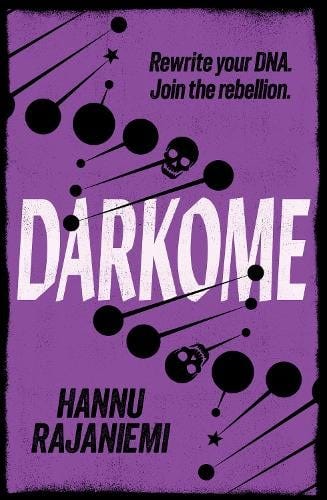No. 88 — Darkome ⫶ Subjective synthetic biology curriculum ⫶ House Rules in Fortnite
Then Comes the Body
My name is Linda. I write a bi-weekly newsletter about computer science, childhood, and culture. Full disclosure: I’m also an investor in one of Hannu’s companies.
Last week, I finished reading Darkome (out also in Finnish as Varjomi), a new book by Hannu Rajaniemi. While reading, I kept highlighting notes, thinking the book could make for a marvellous curriculum around synthetic biology.
Like James Somners, I should have loved biology. But the way it was taught in the early 2000s was, well, lifeless. If I had been introduced to Darkome as a teenager, my career path might have looked very different.
Darkome follows Inara, a young biochemist in a world recovering from a "Decade of Plagues." It's a world with mRNA vaccines, biotech companies that may not be as benevolent as they seem, open-source biology experiments, app stores for vaccines, and stolen data models. The plot moves quickly, and since this is just the beginning of a series, there's much more to come.
I’ve long believed that stories can spark interest in science (see, for example, No. 58 - Science syllabuses with fiction ⫶ The Other Oppenheimer ⫶ Maps of Matter). One project I keep revisiting is the Halt and catch fire syllabus, based on the TV series. It expands into topics like emulations, RFC discussions, and more. (Perhaps in the future, any work of fiction could be turned into a personalized learning plan with help from generative AI.)
So, after reading Darkome, I envisioned a very subjective curriculum for curious students:
1. Biology as a Process of Becoming
“Biology is a study, not in being, but in becoming.” – Carl Woese & Nigel Goldenfeld (Darkome, location: 37)
Evolution, adaptation, and transformation in biological systems.
Have students create a timeline of evolutionary transitions, highlighting the process of "becoming" rather than fixed states.
Twenty Things to Make with Biology by Yasmin B. Kafai & Justice T. Walker. Engage students in making biological projects or experiments, emphasizing creativity and learning through hands-on activities.
2. Symbiosis and the "Human Mycelium" Concept
“We need a human mycelium. We’re too alone, too disconnected. It wants to talk to us, too, and it’s been trying.” (Darkome, location: 1,000)
Fungal networks (mycelium), symbiosis in ecosystems, and the human microbiome.
Set up an experiment observing fungal growth or microbial cultures to explore symbiosis. Students can document and track changes over time.
Isabel Correa growing mycellium with NYC teenagers in a local urban park
3. Cancer Cells as "Dark Twins"
“Cancer cells were our dark twins, it had said, malevolent but superior versions of ourselves. Better at everything we did, better at surviving, growing. And evolving.” (Darkome, location: 746)
Cellular mutation, cancer biology, and evolution at the cellular level.
Present a case study on cancer treatments and discuss how cancer cells adapt. Students could suggest strategies for targeting these adaptable cells.
Decoding cancer. An activity to analyze and diagnose a breast cancer in a patient.
4. Molecular Biology as Craft and Immersive AR Learning
“Molecular biology was a craft, you actually had to do physical stuff, a much higher bar than programming. But Donnie and his relatives could turn any protocol into a fully immersive AR experience and guide you through every step in real time. Mom had always emphasised the need to do things yourself, though. You needed that muscle memory and instincts when you were doing things that were completely new.” (Darkome, location: 973)
Molecular biology basics, lab safety, and augmented reality in science education.
Virtual lab tour or AR module on a molecular biology procedure. Students can perform an experiment virtually, then discuss how muscle memory plays a role in real lab settings.
BioBuilder looks very promising. For AR learning, I remember meeting founders of Labster years ago.
5. The Ethics and Impact of Garage Biology
“I felt a touch of awe. The disc in my hand was a miniature genomics lab and vaccine factory. It had more capabilities packed into it than all the equipment in the houseboat, maybe more than the Harbour’s big community lab. Its microfluidic mRNA synthesiser could have done my two-week production run in minutes. Not only that, devices like it had saved civilisation, and were well on their way towards transforming medicine for ever. All for a price, of course. Aspis was the antithesis of everything the Harbour and Darkome stood for.” (Darkome, location: 58)
DIY biology, bioethics, and regulatory frameworks surrounding biohacking
Lead debates on the ethics of garage biology, using examples from Darkome and real-world biohacking cases. Students can research and present arguments for or against the movement.
Linked List
In computer science, a linked list is a linear collection of data elements whose order is not given by their physical placement in memory. But here it is a selection of things I’ve been reading lately.
House Rules in Fortnite. DHH’s family rules: “Stay together. No complaining.” I love examples like these that efficiently frame how video games can be a part of family life.
Richard Vijgen’s Hyperthread, woven microchip patterns are gorgeous. His other work is intriguing, too.
Then Comes The Body. I thoroughly enjoyed this 14-minute documentary about a ballet studio in Lagos.
Classroom
I’m hoping to surface and share stories from all of you and I’d love to see your creations! Here are a few teachers using Ruby in creative, fun and inspiring ways.
I’m not 100% sure what a playground review ought to look like (and who should write it), but I love seeing people at the park, sharing their experiences. Here are a few.










Linda, this is such perfect timing as I was trying to recall a post you shared previously, about the data contained in our oxygen that we share with each other in live concerts and theatre settings, that heightens the sense of connection with others - can you remind me what that is called again, the breath data..?